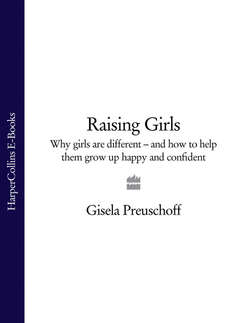Читать книгу Raising Girls: Why girls are different – and how to help them grow up happy and confident - Gisela Preuschoff - Страница 9
Between the ears
ОглавлениеWith sexual differentiation, male and female embryo brains start to develop differently. The clearest distinction can be seen in the hypothalamus, the hormonal centre or ‘relay station’ of the front and middle brain. From here, numerous bodily functions – sexual arousal, hunger, thirst, feeling hot and cold, and fight or flight reactions – are regulated. Here there is also a pinhead-sized group of cells, the so-called ‘third interstitial nucleus of the anterior hypothalamus’. It is thought that this area controls sexual desire. The size of this group of cells is identical for boys and girls when they are infants, but it begins to grow in boys from the age of ten; and by the onset of puberty, boys have two and a half times more nerve cells here than girls.
The most often debated difference between the male and female brain, however, concerns the band of nerve cells connecting the right and left cerebral hemispheres. This bridge, corpus callosum, is definitely larger in the female brain, and it may explain differences between male and female thought processes. Girls and women use both cerebral hemispheres simultaneously, while males use only one at a time.
It has also been proven that girls’ left cerebral hemisphere matures more quickly than that of boys. As the speech centre lies in here, boys – as a rule – learn to speak later than girls. The right cerebral hemisphere, which is responsible for the solution of spatial-visual problems, develops later in girls, which is why young girls often have difficulty imagining objects from different perspectives and orienting themselves spatially.
Birth differences
As a rule, the birth of a boy lasts an average hour and a half longer than that of a girl, perhaps because boys have an average 5 percent greater body weight at birth than girls. If a girl seems very contented as an infant, for example, it might be because her birth went smoothly and she had no traumatic birth experiences. In 1987 in Finland, it was established that newborn boys had a 20 percent higher risk of low Apgar scores than girls (the Apgar system is an index developed by the American doctor, Virginia Apgar, which states a newborn’s vital signs; measurements are taken of breathing, pulse, base colour, appearance, reflexes). Premature births, vulnerability to mental disturbances and infections, and likelihood of accidents are all distinctly lower with girls than with boys.2 A girl’s parents are lucky: female babies are tougher and more robust than boys. We can only speculate about all the factors that contribute to this imbalance, but we can say that cortisol – the stress hormone – and testosterone, which boys build up, heighten the vulnerability of the immune system in male infants.
Perhaps the fact that girls are more socially attuned after birth and maintain eye contact longer than boys is connected to this higher probability of good health for them. They also react more strongly to noises and to other people present in the room, cry less often and are pacified more easily.
Even during pregnancy, the female body is three weeks ahead of the male in terms of bone development. At birth, female babies are already four to six weeks ahead of boys developmentally. At puberty, most girls are clearly and visibly at least two years ahead of their male classmates in development – clearly, these differences began very early in the piece.
